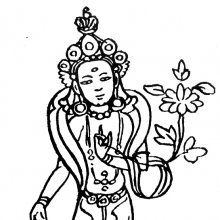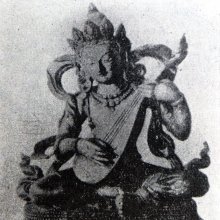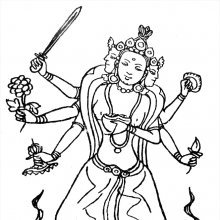Mahasarasvati, Mahāsarasvatī, Maha-sarasvati: 4 definitions
Introduction:
Mahasarasvati means something in Buddhism, Pali, Hinduism, Sanskrit. If you want to know the exact meaning, history, etymology or English translation of this term then check out the descriptions on this page. Add your comment or reference to a book if you want to contribute to this summary article.
Images (photo gallery)
In Buddhism
Tibetan Buddhism (Vajrayana or tantric Buddhism)
Source: archive.org: The Indian Buddhist IconographyMahāsarasvatī (महासरस्वती) is one of the forms of Sarasvatī, as mentioned in the 5th-century Sādhanamālā (a collection of sādhana texts that contain detailed instructions for rituals).—Her Colour is white; her Symbols are varada-mudrā (right) and lotus (left);
The Dhyāna (meditation instructions) of Mahāsarasvatī described in the Sādhanamālā as follows:—
“The worshipper should think himself as goddess Mahāsarasvatī, who is resplendent like the autumn moon, rests on the moon over the white lotus, shows the varada-mudrā in her right hand, and carries in the left the white lotus with its stem. She has a smiling countenance, is extremely compassionate, wears garments decorated with white sandal-flowers. Her bosom is decorated with the pearl-necklace, and she is decked in many ornaments; she appears a maiden of twelve years, and her bosom is uneven with half-developed breasts like flower-buds; she illumines the three worlds with the immeasurable light that radiates from her body”.
[This is the general appearance of Sarasvatī, and all the other varieties,unless otherwise stated, are identical in appearance with the one just described. The distinctive feature of this goddess Mahāsarasvatī is that she shows like the ordinary Tārās the varada-mudrā in the right hand and carries the lotus in the left and is surrounded by four deities identical in form with herself Prajñā is in front of her, Medhā to her right, Smṛti to her left, and Mati in the west. These four divinities may also accompany other varieties of Sarasvatī. As the sādhana is silent about the particular āsana, she may be represented in any attitude, sitting or standing.]

Tibetan Buddhism includes schools such as Nyingma, Kadampa, Kagyu and Gelug. Their primary canon of literature is divided in two broad categories: The Kangyur, which consists of Buddha’s words, and the Tengyur, which includes commentaries from various sources. Esotericism and tantra techniques (vajrayāna) are collected indepently.
Languages of India and abroad
Sanskrit dictionary
Source: Cologne Digital Sanskrit Dictionaries: Monier-Williams Sanskrit-English DictionaryMahāsarasvatī (महासरस्वती):—[=mahā-sarasvatī] [from mahā > mah] f. the gr° Sarasvatī, [Catalogue(s)]
[Sanskrit to German]
Sanskrit, also spelled संस्कृतम् (saṃskṛtam), is an ancient language of India commonly seen as the grandmother of the Indo-European language family (even English!). Closely allied with Prakrit and Pali, Sanskrit is more exhaustive in both grammar and terms and has the most extensive collection of literature in the world, greatly surpassing its sister-languages Greek and Latin.
See also (Relevant definitions)
Partial matches: Maha, Sarasvati.
Starts with: Mahasarasvatidvadashanamastotra, Mahasarasvatistavaraja, Mahasarasvatistotra, Mahasarasvatisukta.
Full-text (+28): Mahasarasvatisukta, Mahasarasvatistotra, Mahasarasvatistavaraja, Mahasarasvatidvadashanamastotra, Dvitiyarcanakalpalata, Sundari, Subhaga, Candi, Vasudeva, Vishnu, Sarasvati, Krishna, Janardana, Shati, Hrishikesha, Uma, Vak, Kshudha, Vedagarbha, Dautapuja.
Relevant text
Search found 6 books and stories containing Mahasarasvati, Mahāsarasvatī, Maha-sarasvati, Mahā-sarasvatī; (plurals include: Mahasarasvatis, Mahāsarasvatīs, sarasvatis, sarasvatīs). You can also click to the full overview containing English textual excerpts. Below are direct links for the most relevant articles:
The Indian Buddhist Iconography (by Benoytosh Bhattachacharyya)
Figure 230 - Hindu Gods: Mahāsarasvatī
Figure 231 - Hindu Gods: Vajravīṇā Sarasvatī
Cidgaganacandrika (study) (by S. Mahalakshmi)
Part 1 - Origin of Tantric system < [Philosophy of Kashmir Tantric System]
Verse 31 [Place of Parāvāk] < [Chapter 2 - Second Vimarśa]
Varahi Tantra (English Study) (by Roberta Pamio)
Chapter 14 - The worship of Caṇḍī < [Summary of the Vārāhī Tantra]
Rivers in Ancient India (study) (by Archana Sarma)
4. The rivers in the minor Upaniṣads < [Chapter 4 - The Rivers in the Āraṇyaka and Upaniṣadic Literature]
The Devi Bhagavata Purana (by Swami Vijñanananda)
Chapter 50 - On the Glory of Śakti < [Book 9]
Chapter 9 - On the narrative of Cākṣuṣa Manu < [Book 10]
Chapter 6 - On the description of the Devī’s Vibhutis (powers) < [Book 3]
Goddesses Durga and Lalita - A Contrast < [July – September 1974]
Related products



